Table of Contents
Quality Service Guarantee Or Painting Free

Get a rental agreement with doorstep delivery

Find the BEST deals and get unbelievable DISCOUNTS directly from builders!

5-Star rated painters, premium paints and services at the BEST PRICES!
Loved what you read? Share it with others!


Submit the Form to Unlock the Best Deals Today
Check Your Eligibility Instantly

Experience The NoBrokerHood Difference!
Set up a demo for the entire community
What is a Commercial Kitchen?
Table of Contents
What is a commercial kitchen? A commercial kitchen is a specialised facility designed for large-scale food preparation and cooking. It's equipped to handle the high demands of various sectors such as restaurants, hotels, and catering services. These kitchens are the operational heart of any food service establishment, providing the necessary environment for professional chefs to prepare, cook, and serve food efficiently on a large scale. The design, equipment, and layout of commercial kitchens are tailored to withstand heavy use while adhering to strict health and safety regulations, ensuring that they can deliver high-quality food service to numerous customers.
Importance of Commercial Kitchens
- High-Volume Cooking: Commercial kitchens are essential for preparing large quantities of food efficiently, catering to hundreds or even thousands of diners each day.
- Health and Safety Compliance: They are designed to comply with strict health and safety regulations, ensuring that food preparation is done in a hygienic and safe environment to prevent foodborne illnesses.
- Professional Standards: These kitchens enable culinary professionals to work in an environment that supports advanced cooking techniques and processes, which are crucial for maintaining the quality and standard of the food served.
- Economic Efficiency: With the use of industrial-grade equipment and optimised layouts, commercial kitchens increase the speed and efficiency of food preparation, which in turn contributes to cost management and profitability.
- Innovative Culinary Practices: They provide a platform for culinary innovation, allowing chefs to experiment with new recipes and cooking methods, which can lead to unique dining experiences and enhanced customer satisfaction.
Design and Layout of Commercial Kitchens
The design and layout of a commercial kitchen are critical as they directly impact the efficiency and functionality of the operation. A well-designed commercial kitchen often employs one of several layout designs:
- Assembly Line Layout: Ideal for kitchens that serve a large volume of a particular type of food, such as pizzas or sandwiches, where the preparation moves in a line from start to finish.
- Island Layout: Features a central workstation, usually for cooking, surrounded by peripheral prep and serving areas. This layout facilitates easy communication and access among staff.
- Zone-Style Layout: Divides the kitchen into distinct zones for different tasks like cooking, baking, prep, and washing. This layout helps minimise cross-contamination and streamline operations.
Materials and Build of Commercial Kitchens
Commercial kitchens require materials that can endure heavy use and meet rigorous safety and hygiene standards. Commonly used materials include:
Quality Service Guarantee Or Painting Free

Get a rental agreement with doorstep delivery

Find the BEST deals and get unbelievable DISCOUNTS directly from builders!

5-Star rated painters, premium paints and services at the BEST PRICES!
- Stainless Steel: Widely used for surfaces, appliances, and utensils because it's durable, resistant to corrosion, and easy to clean. Its non-porous nature prevents bacteria buildup, making it ideal for food preparation and cooking areas.
- Non-Slip Floors: Safety is paramount in commercial kitchens where spills are common. Non-slip flooring materials such as textured tiles or rubber mats are essential to reduce the risk of slips and falls.
- Easy-to-Clean Surfaces: Besides stainless steel, surfaces like ceramic tiles and commercial-grade laminates are used for walls and floors. These materials are selected for their ease of maintenance and ability to withstand frequent cleaning with harsh chemicals.
Essential Equipment in Commercial Kitchens
Cooking Equipment
The backbone of any commercial kitchen is its array of cooking equipment. This includes:
- Ranges: Provide a versatile cooking platform where chefs can boil, fry, sauté, and simmer various dishes. Available in both gas and electric models, they are chosen based on the kitchen’s utility setup and chefs' preferences.
- Ovens: Essential for baking, roasting, and broiling. Commercial kitchens often feature convection ovens that use fans to distribute heat evenly, speeding up cooking processes and improving consistency.
- Griddles: Ideal for cooking a variety of foods at consistent temperatures, making them perfect for pancakes, burgers, and other flatbreads.
- Deep Fryers: Used for deep-frying foods in large quantities. Equipped with temperature controls, they allow for precise and efficient frying.
Refrigeration
Proper refrigeration is critical to keep ingredients fresh and safe:
- Reach-In Refrigerators and Freezers: Common for most kitchens, these are used for storing everything from perishable produce to pre-cooked dishes.
- Walk-In Refrigerators and Freezers: Essential for larger operations, these units offer substantial space to store bulk ingredients and large prepared items.
- Undercounter Units: Space-saving solutions that provide additional refrigeration storage right where it’s needed, ideal for compact areas.
Preparation Equipment
Efficient preparation requires high-quality tools designed for speed and consistency:
- Industrial Mixers: For dough, batters, and other mixtures, these mixers come in various sizes depending on the volume of food that needs processing.
- Slicers: Vital for precision slicing of meats and vegetables, ensuring uniformity that is especially important for presentation and cooking time.
- Blenders and Food Processors: These are used to puree, chop, and mix ingredients quickly, crucial for dressings, sauces, and refined dishes.
Safety Equipment
Safety equipment is non-negotiable in the hazardous environment of a commercial kitchen:
- Fire Extinguishers: Kitchens must have class K fire extinguishers for grease fires and other types specific to the risks present.
- Ventilation Systems: Proper ventilation is essential not only for removing cooking fumes and heat but also for maintaining air quality.
- First Aid Kits: Ready access to first aid kits is required for immediate response to minor injuries in the kitchen.
Technology in Commercial Kitchens
Changing Landscape with Technology
The integration of technology in commercial kitchens has transformed how these culinary environments operate. Smart appliances and sophisticated software systems are now at the core of modern kitchens, streamlining processes and boosting productivity. Here’s a look at some of the technological advancements reshaping commercial kitchens:
- Smart Appliances: These appliances come equipped with connectivity features that allow for remote monitoring and control. For example, ovens can now be preheated from a smartphone app, and chefs can monitor cooking temperatures from afar to ensure precision.
- Inventory Management Software: This software automates the tracking of ingredients and supplies, reducing errors in ordering and stocking. It helps in maintaining a balance between demand and supply, ensuring that nothing goes to waste.
- Point of Sale (POS) Systems: Advanced POS systems not only process transactions but also integrate with inventory and kitchen management systems to provide real-time data on what’s being consumed and what needs restocking.
Benefits of Technology Integration
Incorporating technology into commercial kitchens offers multiple advantages that enhance operational efficiency and sustainability:
- Increased Efficiency: Automated equipment and processes significantly cut down the time needed for various kitchen tasks, from cooking to cleaning. This allows kitchen staff to focus more on creativity and service quality.
- Waste Reduction: Technologies like inventory management systems help track food usage accurately, which minimises waste by ensuring optimal purchase and use of ingredients. Smart appliances can also contribute to energy efficiency by reducing electricity and water usage.
- Enhanced Consistency and Quality: With programmable appliances, each dish can be replicated with the same taste and quality standards, which is crucial in maintaining customer satisfaction and loyalty.
Legal Requirements and Health Regulations
Running a commercial kitchen involves more than just preparing food. It requires adherence to a set of stringent legal and health regulations designed to ensure the safety and well-being of both consumers and staff. These regulations are critical in maintaining public health standards and avoiding legal complications. Here’s an overview of the essential codes and certifications that commercial kitchens must follow:
Health Codes and Safety Standards
- Food Handling and Storage: Regulations specify how food must be handled and stored to prevent contamination and spoilage.
- Kitchen Hygiene: Standards enforce regular cleaning and maintenance routines for all areas of the kitchen, ensuring they are free from harmful bacteria and pests.
- Employee Health: Guidelines require that all kitchen staff undergo health checks and are trained in hygiene practices to avoid cross-contamination.
Certifications and Inspections
- Food Safety Certifications: Kitchen staff often need certifications in food safety, which include training in best practices for food handling and preparation.
- Health Department Inspections: Periodic checks by the health department ensure compliance with food safety standards and hygiene practices.
- Fire Safety Inspections: Fire department inspections verify that the kitchen is equipped with appropriate fire suppression tools and that safety measures are in place.
Challenges in Managing a Commercial Kitchen
Managing a commercial kitchen involves navigating several challenges that can impact operations and profitability. These include managing high operational costs, maintaining complex equipment, and ensuring staff are well-trained and efficient.
Common Challenges
- High Operational Costs: Running a commercial kitchen is expensive, with costs including utilities, ingredients, labour, and rent. Energy-efficient practices and bulk purchasing can help manage these expenses.
- Equipment Maintenance: Commercial kitchen equipment is high-performance and often requires regular maintenance to prevent breakdowns, which can be costly and disrupt kitchen operations.
- Staff Training: Ensuring that all kitchen staff are properly trained is vital for efficient and safe kitchen operations. This involves continuous education on the latest culinary techniques and compliance with health regulations.
Tips for Effective Management and Operation
- Streamline Operations: Implementing lean management techniques can help reduce waste and increase efficiency, such as optimising food preparation processes and improving inventory management.
- Regular Maintenance Schedules: Establishing regular maintenance checks for all equipment helps prevent unexpected malfunctions and prolongs the lifespan of the machinery.
- Invest in Staff Development: Regular training programs can enhance skills and improve staff morale. This investment not only increases productivity but also helps in retaining skilled workers.
- Adopt Technology Solutions: Utilising modern technology, such as POS systems and inventory management software, can streamline operations and provide real-time data to help make informed decisions.
Trends in Commercial Kitchen Design
The landscape of commercial kitchen design is continuously evolving, influenced by both technological advancements and changing culinary trends. Below are some of the notable trends in the industry, as well as insights into the future outlook for commercial kitchens.
Current Trends
- Sustainable Practices: Environmental sustainability has become a significant focus in kitchen design. This includes the use of energy-efficient appliances that reduce electricity usage, water-saving fixtures to minimise water waste and systems that recycle heat from appliances to warm up water or the kitchen itself.
- Local Ingredient Sourcing: There is a growing emphasis on farm-to-table dining experiences, where kitchens source ingredients locally. This not only supports local farmers and reduces transportation emissions but also ensures fresher ingredients in the kitchen.
- Compact and Flexible Designs: As real estate costs rise, there is a trend towards smaller, more flexible kitchen designs that maximise space efficiency. This includes modular equipment that can be easily rearranged or updated as the menu or service style changes.
Future Outlook
- Technology Integration: The future of commercial kitchens looks to be driven by further integration of technology. Smart kitchens, equipped with IoT devices that can predict maintenance needs and manage inventory through AI, are on the rise.
- Health and Wellness: Kitchens will likely continue to adapt to consumer preferences for healthier food options, which will influence not only the ingredients used but also how food is prepared.
- Automation: As labour costs continue to be a challenge, automation in food preparation and delivery is expected to expand. Robotic systems and automated cooking appliances can help kitchens increase output while maintaining consistent quality.
Estimated Budget for a Commercial Kitchen
Setting up and maintaining a commercial kitchen involves a considerable financial commitment. The total cost can vary widely depending on the size, location, and specific needs of the kitchen. Here's a breakdown of the primary cost areas to consider.
Initial Setup Costs
- Equipment: This is typically the most significant part of the budget. Commercial kitchens require high-quality, durable equipment like refrigerators, ovens, stoves, and dishwashers. Depending on the quality and quantity of equipment, costs can range from a few thousand to several lakh rupees.
- Design and Construction: The layout and design of a kitchen impact its efficiency and safety. Professional kitchen designers and contractors can be hired to optimise space and flow, which involves an initial investment but can lead to long-term savings in operating costs.
- Permits and Licensing: Before opening, a commercial kitchen must comply with local regulations, which may require various permits and licenses. These costs will vary by location but can be substantial.
Ongoing Operational Costs
- Labour: Staff salaries are a continuous expense in commercial kitchens. The cost depends on the number and skill level of the employees needed to operate efficiently.
- Utilities: Commercial kitchens consume a lot of energy, especially gas and electricity. Efficient appliances and sustainable practices can help manage these costs.
- Maintenance and Repairs: Regular maintenance is crucial to keep kitchen equipment running efficiently and to avoid costly repairs. Setting aside funds for potential equipment failures and routine check-ups is a wise financial strategy.
- Supplies and Ingredients: The cost of food supplies can fluctuate based on market conditions and the type of cuisine offered. Purchasing from local suppliers and buying in bulk are strategies to help manage these expenses.
5 Innovative Commercial Kitchen Design Ideas
Commercial kitchens are evolving to meet the demands of modern culinary arts and technology. Here are five innovative design ideas that are transforming these spaces, each with its unique benefits and challenges.
1. Open Kitchen Layout
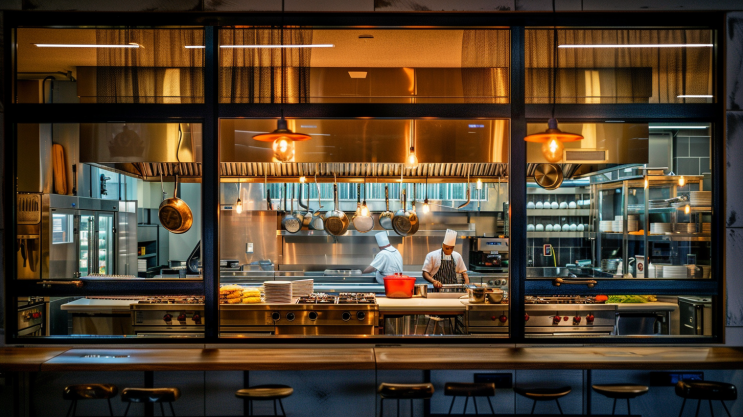
- Benefits: An open kitchen design allows customers to view the cooking process, which can enhance their dining experience by adding a sense of transparency and entertainment. This layout can also facilitate better communication between the kitchen staff and the dining area.
- Challenges: Maintaining a spotless kitchen becomes crucial as it is in full view of the customers. Noise control can also be an issue, as the sounds from the kitchen can be carried into the dining area.
2. Modular and Flexible Design
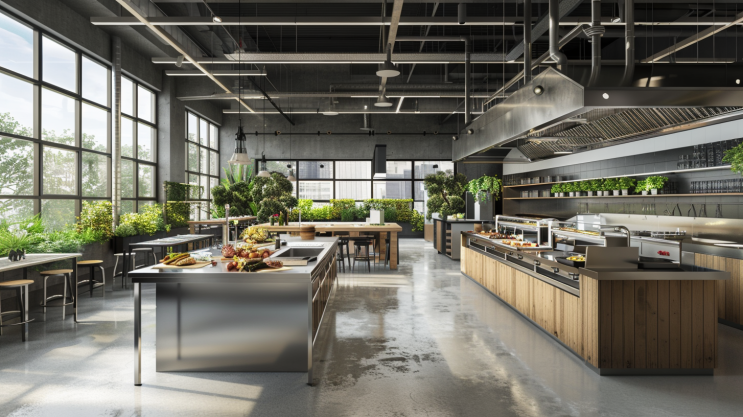
- Benefits: Modular designs offer the flexibility to adapt the kitchen layout as needed. Equipment on wheels, adjustable shelves, and counters can be reorganised to accommodate different services or menu changes.
- Challenges: The initial cost for modular equipment can be higher than fixed installations. Additionally, the frequent moving of equipment might increase wear and tear.
3. Ergonomic Design

- Benefits: An ergonomically designed kitchen prioritises the comfort and efficiency of the staff, potentially reducing fatigue and the risk of injuries. Features might include varied counter heights to suit different tasks and workers and easily accessible storage.
- Challenges: Designing a truly ergonomic kitchen requires a detailed understanding of operations and can involve custom-made elements, which can elevate the cost.
4. Energy-Efficient Kitchen

- Benefits: Incorporating energy-efficient appliances and sustainable materials can significantly reduce utility costs. Features like LED lighting, ENERGY STAR-rated appliances, and efficient ventilation systems contribute to a greener operation.
- Challenges: The upfront cost for high-efficiency appliances and systems can be substantial, though they offer long-term savings.
5. Automation-Enhanced Kitchen
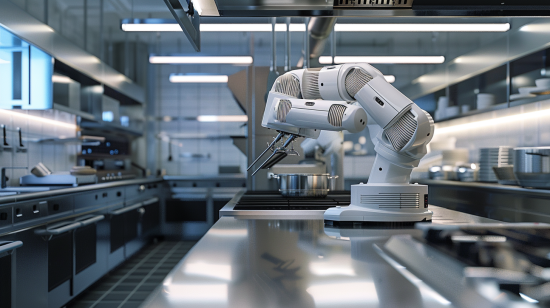
- Benefits: Automation can streamline operations, from food preparation to cleaning. Automated systems can improve consistency in food quality, reduce labour costs, and increase kitchen safety.
- Challenges: Integrating advanced technology and automation requires a high initial investment and training for staff. Dependence on technology also introduces risks of mechanical failures which can disrupt operations.
Elevate Your Commercial Kitchen with NoBroker Interior Design!
Commercial kitchens play a pivotal role in the culinary world, serving as the backbone of food service operations. Setting up such a space requires expert planning and execution to ensure functionality and compliance with health regulations. For a seamless setup of your commercial kitchen, consider NoBroker Interior Design Service. We specialise in crafting kitchens that not only meet professional standards but also optimise workflow and aesthetics. Let us help you navigate the complexities of what is a commercial kitchen with our expert design solutions.
Interested in transforming your culinary space? Contact NoBroker Interior Design today and start your journey towards a state-of-the-art commercial kitchen.
Frequently Asked Questions
Ans: When building a commercial kitchen, prioritise efficient layout & high-quality materials, and incorporate equipment that meets your specific culinary needs and complies with health regulations.
Ans: To build a commercial kitchen, start by consulting with a kitchen designer to create a layout that maximises efficiency and complies with health regulations. Then, invest in high-quality, durable equipment suited for high-volume cooking.
Ans: The cost to build a commercial kitchen in India can vary widely, typically ranging from ₹20 lakhs to over ₹75 lakhs, depending on the size, equipment, and specific requirements of the operation.
Ans: Converting a kitchen into a commercial space requires upgrading to meet regulatory standards, including commercial-grade equipment and appropriate layout changes.
Ans: Staff typically require training in food safety, equipment use, and emergency procedures to ensure compliance and safety in commercial kitchens.
Loved what you read? Share it with others!
Most Viewed Articles
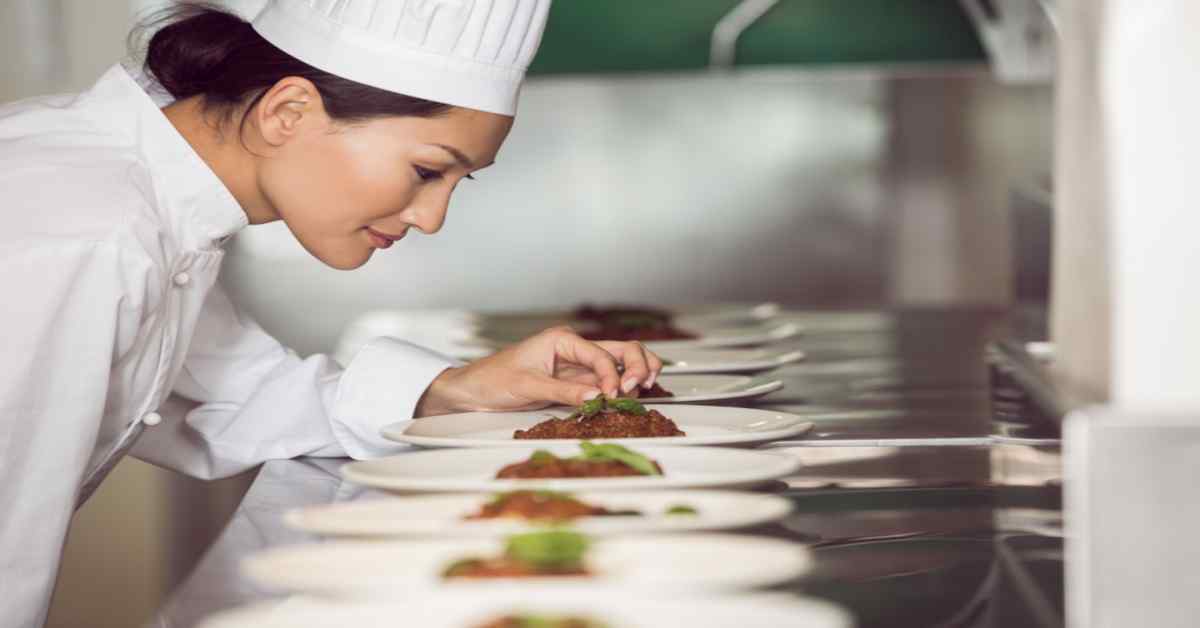
Latest Restaurant Kitchen Design Ideas 2025
January 31, 2025
4023+ views
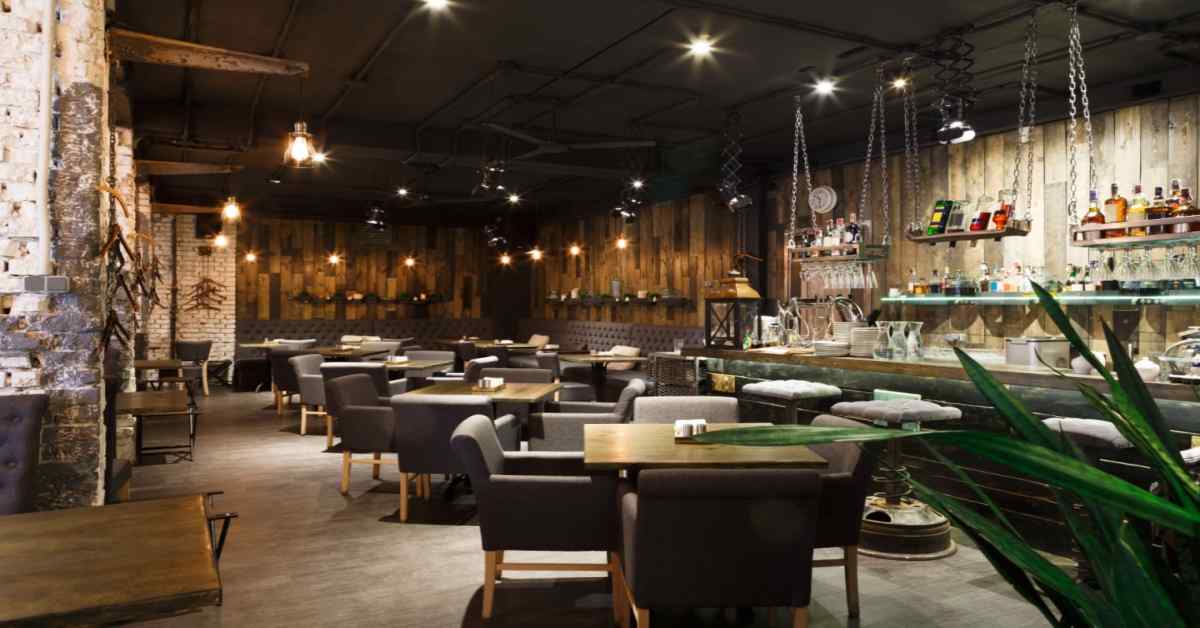
Restaurant Interior Design Ideas 2025
January 31, 2025
2933+ views

January 31, 2025
2850+ views

Small Shop Front Elevation Design: Creative Ideas to Make Your Storefront Stand Out in 2025
January 31, 2025
2838+ views

January 31, 2025
2672+ views
Recent blogs in
January 31, 2025 by Priyanka Saha
Restaurant Interior Design Ideas 2025
January 31, 2025 by Priyanka Saha
Latest Restaurant Kitchen Design Ideas 2025
January 31, 2025 by Priyanka Saha
Top 14 Commercial Building Elevation Designs of 2025
January 31, 2025 by Priyanka Saha





Join the conversation!